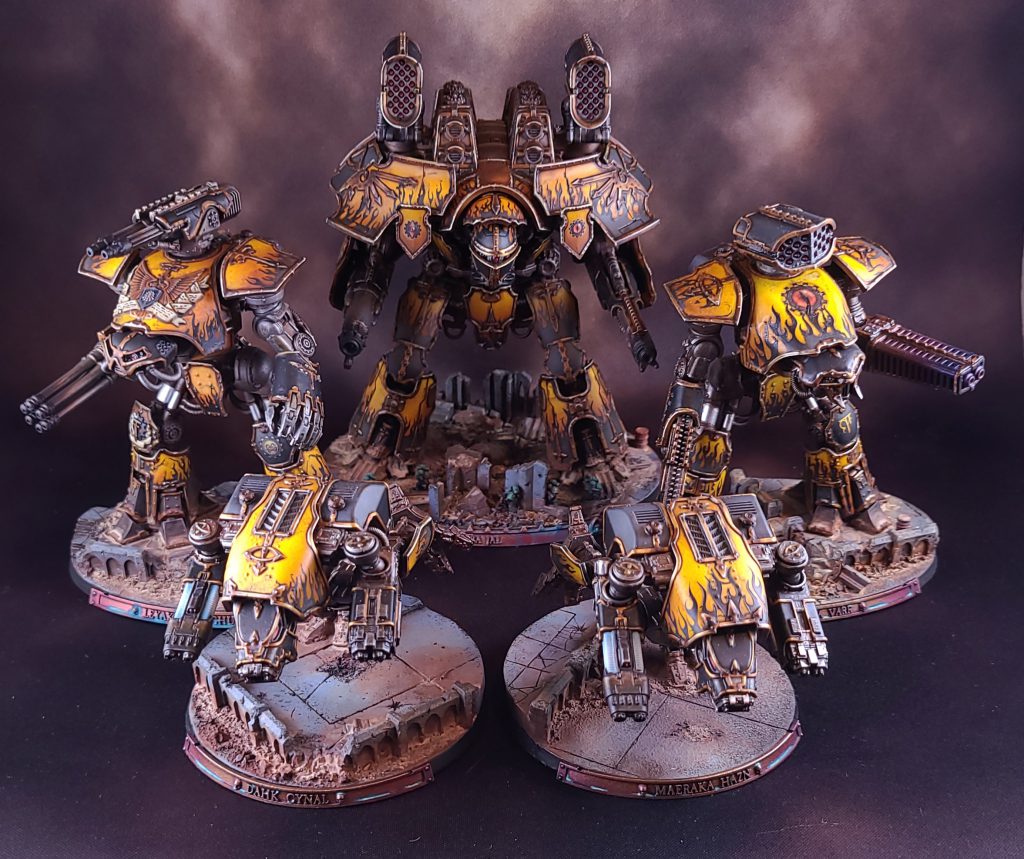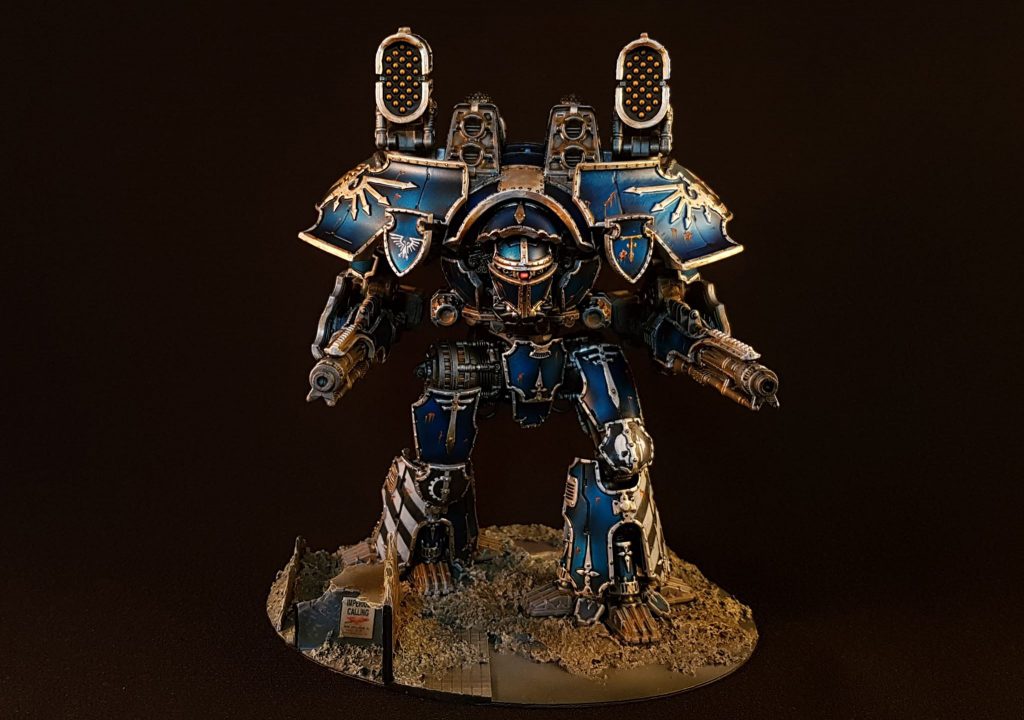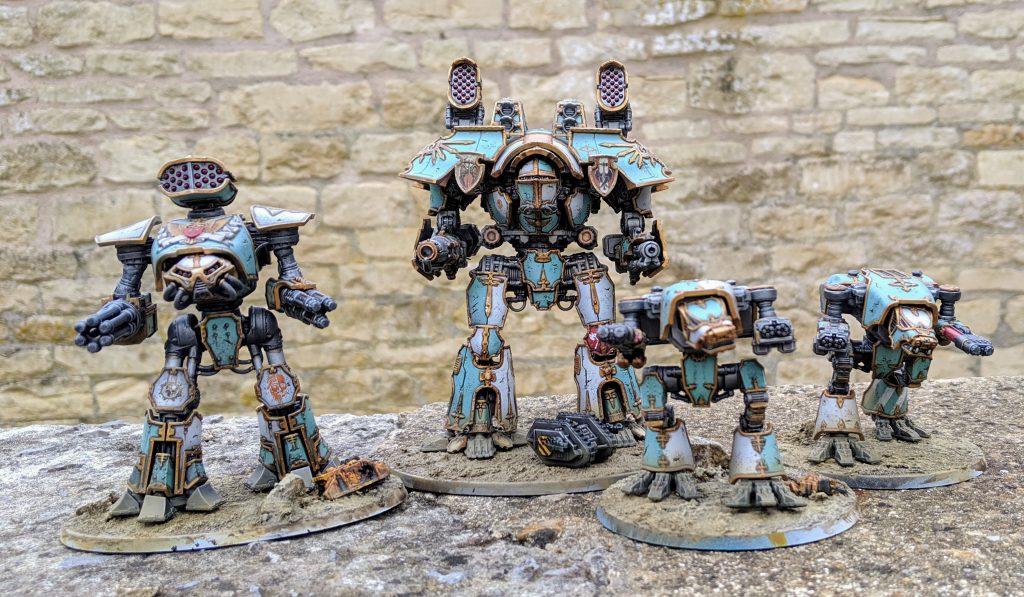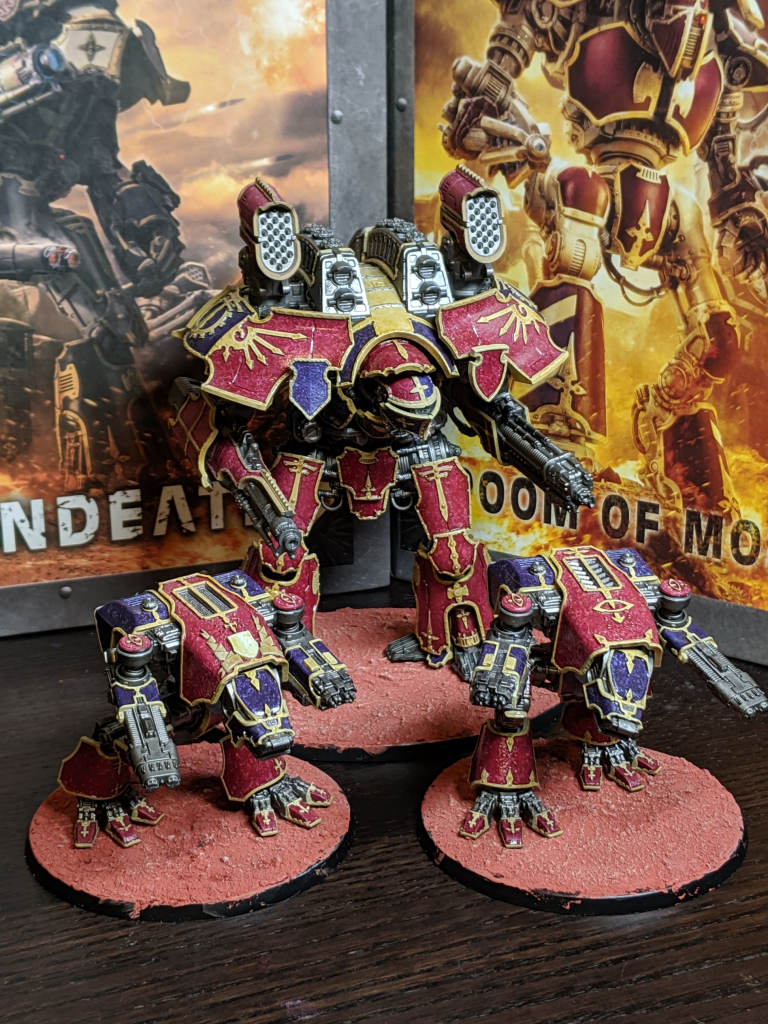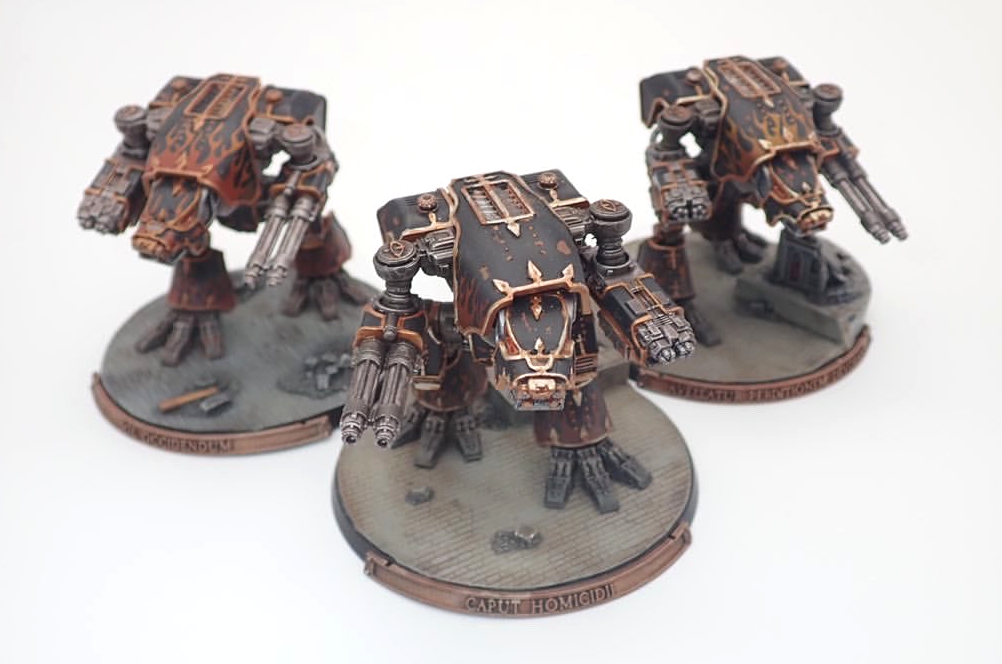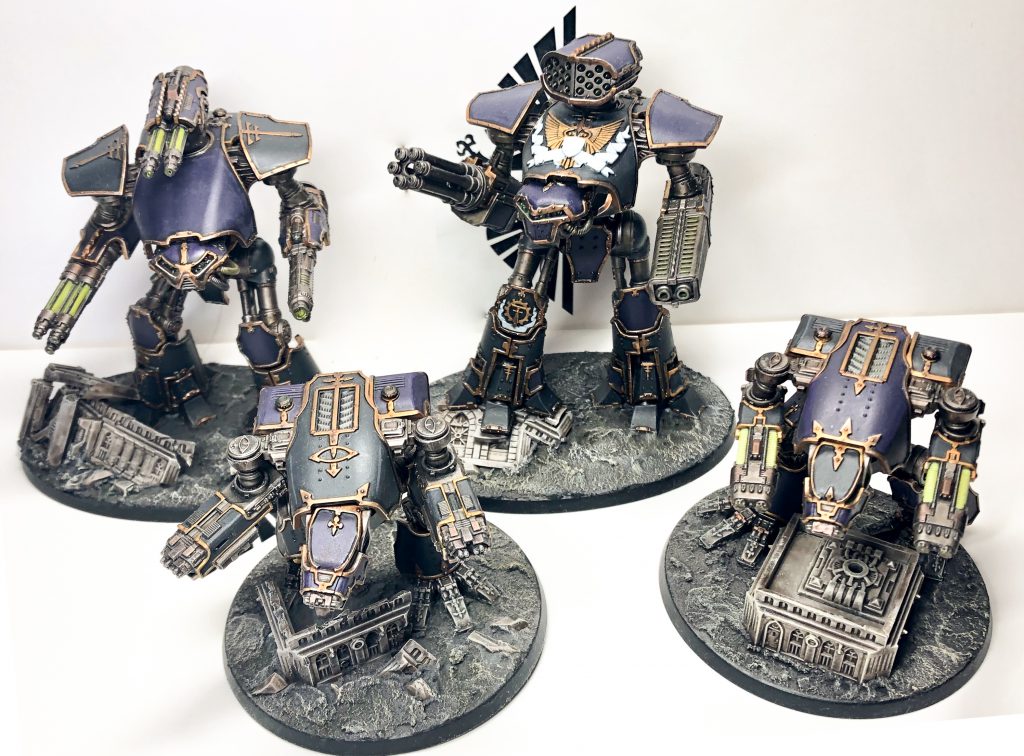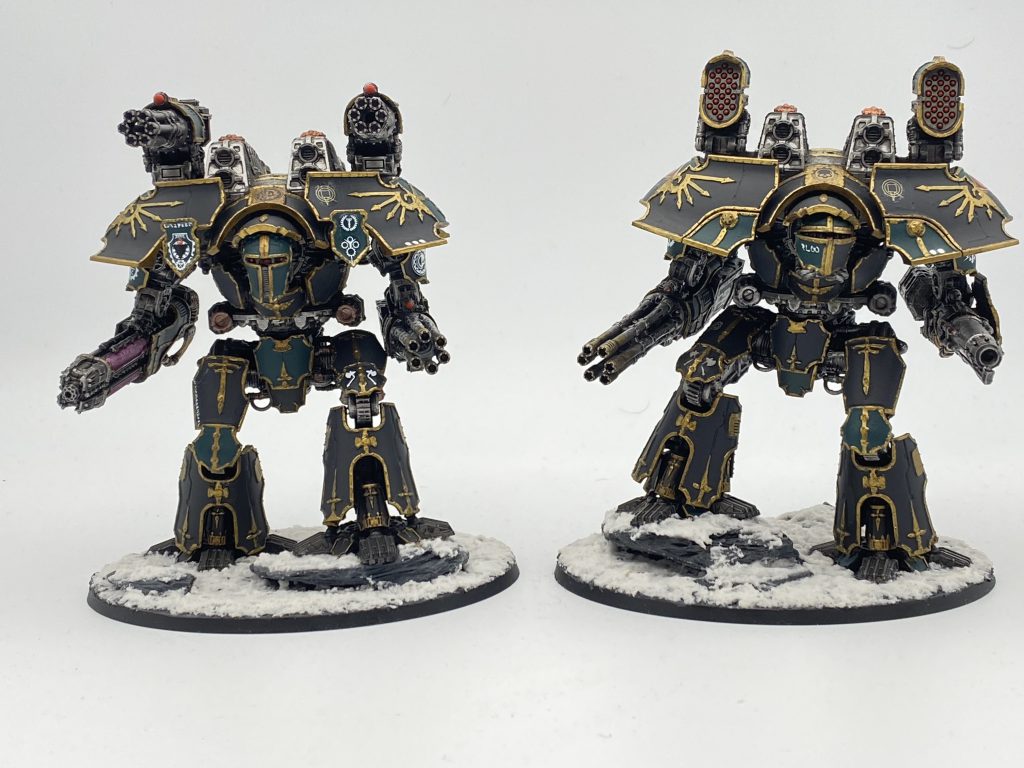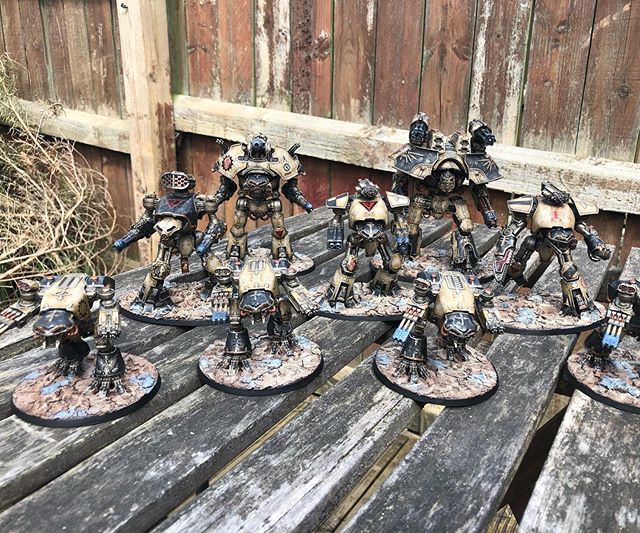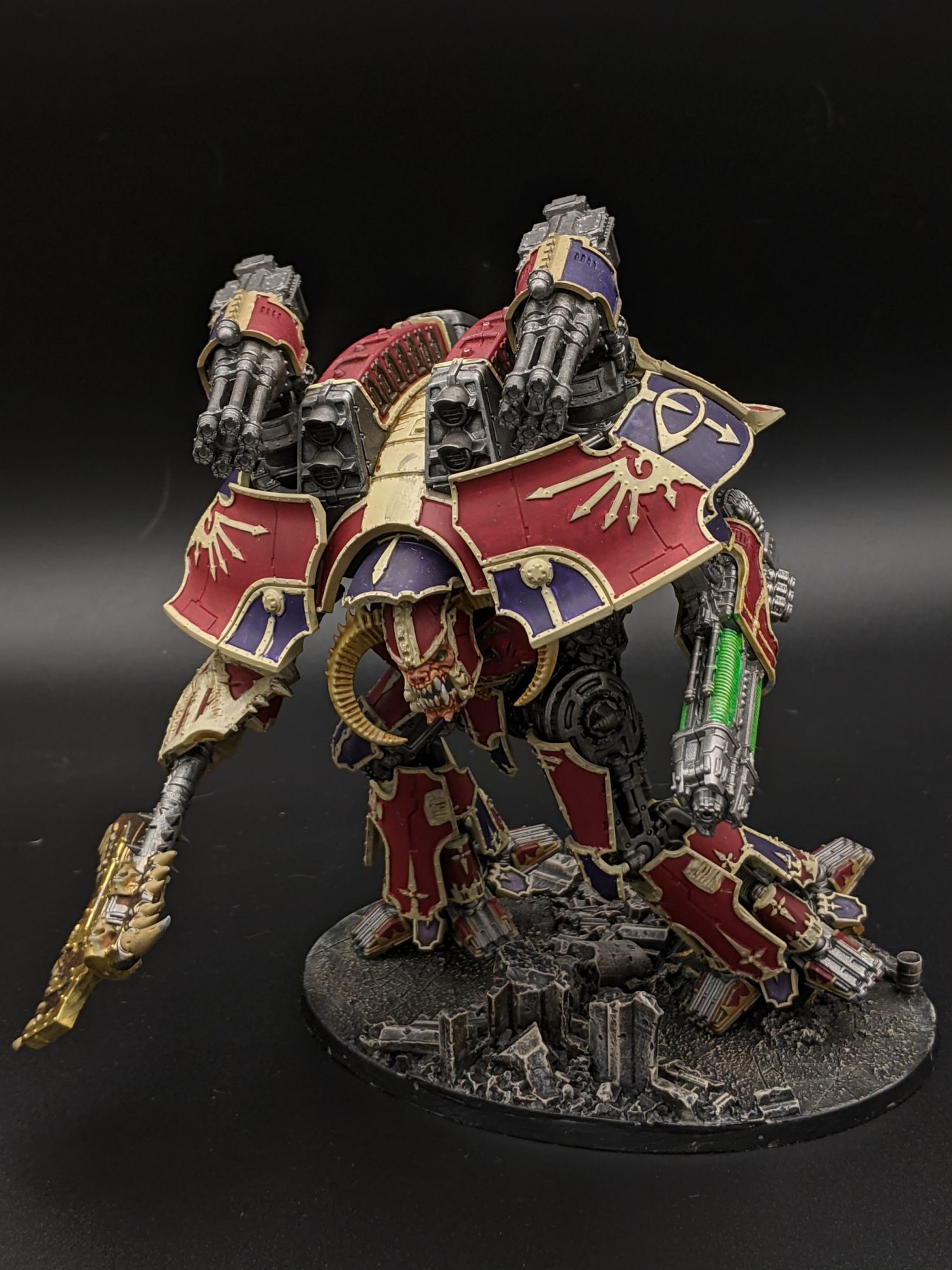Back in April, GW gave Loyalist players everywhere a new lease on life with their release of the Loyalist Legios supplement. Offering revised rules, the introduction of legio-agnostic wargear, and a single resource for all loyalist players regardless of what supplement you pulled your legion from, Loyalist Legios was a must-buy for anyone playing a Titan Legio who stayed loyal to the Emperor. However, Titan Principes with a more traitorous bent have been largely left in the cold, wondering when they’d get their supplement.
Well, the wait is over: the Traitor Legios supplement is now up for preorder, and it’s packed full of all the rules you need to wage war in the name of the Warmaster. In addition to pulling together the existing rules into one place and adding in a few new tricks in the form of Traitor-specific wargear, this supplement contains the first appearance of something Traitor players have been waiting for for a long time: the much-anticipated Corrupted Titans.
This book is hefty, clocking in at 176 pages of rules and background material that aims to consolidate everything a Traitor player could need other than the Core Rules. But is it worth the wait? Read on to find out.
Editor’s Note: Games Workshop was kind enough to provide us a review copy of Traitor Legios for this review.
Revised Legion Rules
In addition to the same changes to maniples that show up in the Loyalist Legios supplement, the rules for each of the various Legios have been revisited, with most of them seeing at least some changes. Most of these changes are relatively minor – there are a lot of changes to phrasing that don’t appear to actually affect the application of the rule, but do make them a lot easier to understand – but a few legions are seriously different now. Here’s the highlights:
Legio Tempestus
Glory in Death is largely unchanged, but Fury of the Machine is completely different now – rather than pushing you towards the top of the Awakened Machine Spirit table, it instead gives you a boost to the strength of one of your weapons each round so long as the firing Titan has taken at least one point of Critical Damage.
As far as strats and wargear go, Combat Drop is now a lot more reliable. It’s still expensive at 3SP, but if you want to go for the ultimate outflanking maneuver, dropping a Warhound into the middle of the board is a stronger play than it’s ever been. Meanwhile, Chasmata-Pattern Laser Destructors has seen an interesting change: it’s swapped the range increases for Short and Long to 6” and 3” respectively. This is a great change in our estimation, letting the Stormlords fire laser blasters accurately out to 22”. In other words, if you’re brawling in the middle of the board, your lasers are going to be able to hit at 3+ and make called shots at 5+ in almost all situations, making them a lot more useful. Combine this with the new Fury of the Machine and your critically-injured Titans are pumping out accurate strength 9 firepower, which can get seriously scary.
Legio Mortis
The Warmaster’s Beneficence has seen the only meaningful change for the Death’s Heads, and is a bit more interesting. It’s still a once-per-game effect, but you now get to choose when you use it, which seriously increases its utility. It no longer gives you the free push on Draining weapons, but in exchange lets you choose a single weapon and increase its strength by 1 for the entire round.
Losing the free push seems rough at first, but we think the trade is worth it, especially if you can fire the weapon you nominated more than once per turn. Try to set up First Fire orders and look for generic or traitor-specific stratagems that let you fire multiple times to get the most out of this new trick.
Legio Krytos
Going into this book, the biggest question in our minds was whether Krytos would get any changes, and whether those changes would make their rules worth taking. Well, they’ve changed, and now that we’ve had a chance to look at their new rules them, the verdict is in:
Krytos fuck now.
Doom of Worlds, their Legio Trait, is still there, and it still lets you put an extra Warlord in a Myrmidon. However, it now also lets you shove a Warlord into an Axiom or a Fortis, and lets you swap in a Warbringer Nemesis for one of the Warhounds in a Regia or Precept, or one of the Reavers in a Fortis. And to top it all off, if you do bring the Warbringer in a Regia, it can merge its voids with any Warhounds you bring. This opens up some really cool list-building options that were previously only available to Dauntless and maybe one or two other Legions.
On the stratagem front, their old stratagems have been combined into a single 1SP stratagem, Destroyers of Cities. It adds 2 to the strength of attacks against buildings and reduces the strength of hits from Dangerous terrain by 2 for a round. Not amazing, but cheap. The space left in their rules is filled by an entirely new stratagem, Civilization’s Ruin, clocking in at a hefty 3SP. It’s worth it, though: as long as you don’t put your Titans on Split Fire orders, any weapons with the Quake trait take effect that round even if your target still has voids up. In other words, if you pop this round 1 and hit your opponent’s force with a well placed quake cannon shot, they’re going to move half speed the next round, giving you more time to tear down their voids and blow a volcano cannon-shaped hole in the armor underneath.
Of course, you won’t need to take a Mori to get access to Quake weapons in Krytos: Earthbreaker Missiles are back, and their shot count has doubled from their appearance in Titandeath to 4 shots for a Warlord or 2 for a Reaver. Combined with Civilization’s Ruin, you can stick these on your Warlords and Reavers to lock down difficult targets for a round, giving you crucial time to set up to take them down.
Their Path of Contempt personal trait also got a minor boost: now, you can use it to make a Smash attack against any model that’s smaller than the Princeps’ engine, letting it shoulder check its target in the movement phase, then back up some to create some space. Not incredible, but pretty cool.
All in all, these are an excellent set of changes that finally give the God Breakers their own niche in the rules. Legio Krytos players: your day has finally come.
Legio Vulpa
Two smaller changes, and one big one. First up, Disruption Emitters go up to 35 points, a price increase that they quite honestly deserve. Not a huge change, but it does mean you’ll be having to find about 15-25 points in your lists now, depending on the number of Titans you take. Second, Honour and Blood’s radius has expanded out to 5”, so your opponents will now have an easier time positioning so that the negative part of your Legio trait comes into play.
The other change is a doozy, though: Plasma Gargoyles is gone. In its place is a new piece of wargear for scale-7 and larger Titans, the 20-point Shikarian Conduits. These little beauties increase the boosted speed of the Titan they’re on by 2”, and its boosted manoeuvre by 1. However, the extra power needed to accomplish this is diverted from the weapons systems, decreasing the dice of any weapon without the Melee trait by 1 and imposing a -2 penalty to the Titan’s BS.
These changes serve to cement Legio Vulpa’s position as the premiere close-combat Legio, and the single best option for building around the Arioch Titan Power Claw. Combined with War Lust, a Legio Vulpa Warlord can bound a staggering twenty inches up the board round 1, potentially putting you in range for a turn 2 charge if your opponent isn’t ready for it. And your Reavers can get their boosted speed up to 13” for a turn, potentially adding 4 dice to their melee attack on the charge as they come screaming in for the kill.
If they are ready, though, watch out: that 2-3” “dead zone” in Honour and Blood is not only a full 2” larger – extending out to 5” now – it hurts even more than it used to, since it combines with Shikarian Conduits to push your BS to a pathetic 6+ in a turn you boosted for either speed or turns. Against a canny player, don’t be surprised if your Warlord’s Princeps winds up blazing away in a blind rage, somehow managing to miss a target right in front of their face out of anger at not making their charge.
Legio Interfector
The MURDER LORDS get one change, and not only is it really cool, it also opens up some new tricks: Raving Madman is now a potentially useful personal trait. Once per round, you can change the result of a D10 used to determine who is First Player or for a command check can automatically be a 10, but for whichever you used it for the next time you roll for First Player or a command check then the result is automatically a 1.
This is a super cool effect that has a lot of potential uses. Not only does it let you potentially steal first turn when you absolutely need it, but if you already won the Opus (or don’t mind giving it away), you can guarantee one order at the cost of automatically failing another. We’re stoked to see how people use this.
One thing that’s not clear is whether you can use this with a weapon that has the Fusion trait to shove a critical hit through without having to roll. Even without that clarification, though, it’s a great trait, effectively combining Ironclad Tyrant with a less effective Dominant Strategist at the cost of losing the next roll you used it on.
Legio Infernus
The Fire Masters have seen a huge change: Dark Blessing no longer grants them a re-roll. Instead, it increases the number of Additional Mutations their Titans can have by 1 – more on those below when we get to Corrupted Titans.
Is this trade-off worth it? Maybe. There are some really cool tricks in the Titanica Infernus, and being able to really kit out your Reavers and Warhounds in ways other Legios just can’t is a very cool concept, and one your other Legio rules will encourage you to take advantage of.
However, losing that re-roll is going to hurt (although a similar effect has moved to the Traitor wargear section, which we review below). You’ll have to get creative if you’re going to find a way to make this worth it, but with the number of options for Corrupted Titans, we wouldn’t be surprised if you could find a way.
Legio Mordaxis
The Techno-toxin is stronger than ever, now extending its effects out to 4” rather than just 2”, still ignoring voids. And though it’s gone up to strength 5, it’s still not likely to do much to a Titan that’s not already on the brink of death. That’s fine, though, since this trait got another effect: non-Mordaxis Titans within 4” of a Mordaxis engine subtract 1 from all Repair rolls. This is huge, while a small aura from slow engines not being able to reignite shields within 4” can be devastating.
Of course, Mordaxis won’t have any problem repairing their own Titans, especially now that Unstoppable is more aptly named than ever before. In addition to the extra dice, you’ll also add 1 to the result of each of your Repair rolls during that Damage Control phase, having a solid chance of re-lighting voids and causing critical damage to vanish as though it was never even there. And at 3SP, it doesn’t even cost any more than it used to!
As for their personal traits, two of them have been buffed a bit. First, Proud Protector extends its radius to 4” – a small buff but welcome. This lets you spread your Titans out a little bit further while still being able to take advantage of it. And Harbinger of Decay improves your Princeps’s Techno-toxin to D3+1 strength 7 hits, giving it a reasonable chance of affecting Reavers and Warhounds, and lowering the threshold at which it might take effect on a Warlord.
Bair: I am pumped for these. My Mordaxis is ready.
Legio Tritonis
In a move that will surprise basically no-one, Stygian Veil goes to 3SP. Leader of Arachnus still lets you take it more than once, but reduces the cost of subsequent purchases to 2SP, making it feasible to take two copies of Stygian Veil at 1750 points in most games that aren’t against a Knight Household.
Legio Laniaskara
The Bullish trait has seen a slight de-buff here in that the Smash attacks the Titan can make during a charge do not benefit from the extra attacks of the charge. So your main melee weapon (or original smash attack if you don’t have one) will get the extra attacks for distance moved but the extra smash attack will always be just D3 extra hits. Still fantastic for getting that extra hit or two in to finish off a Titan after the initial hit but not quite as powerful as before.
Legio Vulcanum
The main Legio’s trait Two-Faced God has been updated and now allows 2 Titans per maniple to be a Princeps Seniores, each with their own Princeps Seniores trait. The big change is that support Titans can’t be a Princeps Seniores anymore which means no more Warmaster or Iconoclast Princeps Seniores, which is really probably for the best.
One of their two upgrades too has seen a small clarification: Janus Pattern Missiles must follow the normal restrictions for being fired, so any shots that split off at a different target within 12” has to be within line of sight, arc, range, etc. Before it wasn’t clear if the target had to still be in arc, but it makes sense that it does.
Lastly, the previously-useless Princeps Trait Divided of Mind now gives the Princeps a re-roll to the command check when issuing an order, however if the re-roll also fails then all Titans within the same maniple then lose all of their orders. A big trade-off.
Corrupted Titans
OK, now that you’ve scrolled past all of the changes that we painstakingly reviewed and evaluated, we can get to the part of the book that you’re really here for, the Titanica Infernus, or, as we like to call it, Zen and the Art of Daemon-Engine Maintenance. Ever since the rules for Psi-Titans were released, we’ve known that Corrupted Titans were coming down the pipe. Well, now we finally get to see what they do, and boy howdy are they cool and good.
Rather than being a dedicated new class or sub-class of Titan, Corrupted Titans are made by applying a series of Daemonic modifications to one of your existing Titans. You’ll start by choosing a Base Mutation, which provides a potent upgrade to your Titan depending on which one you choose. For instance, turn a Titan into a Warp Conduit, and it can cause a single strength 10 hit to a location of your choice, straight through void shields. For 15 points, a Titan with a Frozen Soul gets 2 extra dice during the damage control phase, but can only use them to vent heat. And if your Titans aren’t agile enough for you, try spending 20 points for Preternatural Grace, and gain the ability to push for speed or turns once a round without having to roll. You’ll want to be careful with which base mutation you choose, since each Titan can only have one.
Of course, no self-respecting Daemonforge would stop at a single mutation. Once you’ve chosen your base mutation, you can then choose Additional Mutations, which add more tricks and abilities to your Titan. The bigger the Titan, the more you can pick, with Warhounds and Reavers allowed 2, Warbringers and Warlords getting 3, and Warmasters allowed 4 additional mutations. There are a bunch of these, and most of them are pretty cool. A Titan with a Chitinous Carapace subtracts 2 from armour rolls against its body or carapace weapons, but can’t push for speed. Preternatural Regeneration costs a hefty 50 points, but adds an additional 2 repair dice to all repair rolls, all of the time. You could take what’s probably our favorite, Writhing Carapace, which lets you swap your carapace weapon during the Strategy Phase for one costing equal or fewer points than the one it started with. It uses your Command phase activation so you won’t get an order, but being able to swap from Laser Blasters to Paired Gatling Blasters as needed is huge. Some of the additional mutations, like Immaterial Shield, improve on one of the base mutations. You can only take it on a Titan with the Preternatural Grace base mutation, but it imposes a -1 to hit your Titan as long as its voids are still up. And as a bonus, so long as its voids are up, it gets a 5+ save against weapons that would bypass its voids.
This power doesn’t come without a cost, though: the Daemons infesting a Corrupted Titan are less reliable than their human counterparts and more likely to go off-book and ignore orders. In game terms, this translates to a -1 penalty to all Command checks for Corrupted Titans, which increases to -2 if the Titan has any Additional Mutations, meaning that not only will your mutated Titans come at a significant points premium, they’ll have a tougher time with Orders and keeping the entity bound inside in check.
Bair: One thing that can help with getting Orders off while fielding a whole load of mutated Titans would be to field them in a Precept Maniple which lets you choose one order per turn and the Titans get it off on an unmodifiable 2+. The Perpetua has a similar effect but only for Emergency Repairs.
Speaking of that entity, Corrupted Titans exchange the Awakened Machine Spirit table and the legio-agnostic Personal Traits table for the Awakened Entity Table and the Corrupted Titan Personal Traits table, respectively. The Awakened Entity Table is largely similar to the Awakened Machine Spirit table, but there are some differences. The largest change here is the replacement of the Stalwart effect with Fearful, which causes the Titan to move directly backwards instead of getting a chance to repair, moving further the more critical damage it’s taken.
Meanwhile, the new Personal Traits are completely different and the base rulebook ones cannot be chosen for mutated titans, helping sell the idea of what it’s like to try to command a war engine that quite literally has a mind of its own. Beast of Aeons allows the princeps to take any order without having to roll, but if it does, the rest of its maniple can only be issued that same order that phase. Exemplar of Fear is the counterpart to Ironclad Tyrant, instead forcing an enemy Titan within 12” to re-roll a successful command check for an order. But probably the coolest one here is Strong of Essence. When your Titan is destroyed, you choose another nearby Titan of the same class that isn’t corrupted for your bound Daemon to leap to and make a new home in. It brings whatever Base Mutation it had with it, and on a 4+ even maintains the Strong of Essence trait, potentially letting it jump on death a second time but does require having non-mutated Titans.
Bair: I’m really happy that the table has been replaced entirely. It makes the chaos titans feel unique but also means you’re not having loads of mutations and extra effects with abilities like Ironclad Tyrant to mitigate the command penalty or the very-powerful Dominant Strategist.
At the end of the day, the Titanica Infernus presents an interesting trade-off: do you want to sink the points for some terrific effects at the cost of being less likely to keep your engines under control? Or would you rather resist the temptation, play it safe, and play a strategic game with things like “Orders” and “Reactor Management”? There’s a decision to be made here, and it’ll likely take a few games until you get a feel for how far down the rabbithole of corruption you want to go.
Traitor-Specific Wargear
In addition to a reprint of the universal wargear from the Loyalist Legios book, you’ll also get a few new Traitor-Specific Wargear choices. Two of these, the Immateria Ward and Singular Purpose, interact with the rules for Corrupted Titans. The first, Immateria Ward, can only go on a Titan that isn’t corrupted, but lets it count as corrupted for purposes of other Titans’ mutations. Since some mutations give off auras that affect all non-mutated Titans and not just enemy ones you’ll be wanting this. Singular Purpose, on the other hand, goes on a Corrupted Titan, and lets it choose an option on the Awakened Entity table that will always be applied instead of rolling on the table. Given how likely it is that your Daemon engines will decide to go off on their own, this is well worth the investment.
Unholy Benedictions is a 15-point upgrade that gives the Titan it’s equipped on a single re-roll that can be used once per game. However, the re-roll is for the entire roll, not just a single die: for example, if you fire a gatling blaster and use the re-roll on the hit roll, you’ll have to roll all six dice again, not just the ones you want to. This is an incredibly powerful effect, and it’s frequently going to be worth taking. There’s a downside, though: until you use that re-roll, you’ll get a -1 to all Command checks. In effect, this upgrade is a one-use version of Infernus’s old Dark Blessing, but now available to everyone.
As far as weapon upgrades go, you’ve got two useful choices. The first, Corrosive Payload, is a single-use upgrade that you can apply to any weapon with the Ordnance trait. When you use it, it adds 1 to all armor checks for that weapon’s attack. This effect isn’t as game-warping as the Loyalists’ Hunter Shells, but whether you slap it on a Reaver’s gatling blaster or a Warlord’s macro-gatling blaster, either will hit a decent strength breakpoint that will seriously improve their destructive potential.
Your other weapon upgrade is Focused Capacitors, which you can slap on a weapon with the Maximal Fire trait. If you fire the weapon normally, this has no effect, but if you fire it on maximal, it increases the weapon’s strength by 3 but sets its long range to ‘-’, preventing it from being able to make attacks outside short range. Slap this on a Warlord’s sunfury plasma annihilator or a Warhound’s plasma blastgun, and you’ve got a strength 11 weapon, making it that much more reliable and opening up the possibility of critical damage against an undamaged Warlord.
The last upgrade here is Marks of Conquest. It costs 10 points, and imposes a -1 penalty to Command checks on enemy Titans within 10”. Not incredible, but a neat effect if you’ve got the points to spend.
The Infernal Forge
So now that we’ve looked at the rules for Corrupted Titans and the new wargear, let’s take a look at how you could build a Corrupted Titan to have a huge impact on the table.
Vero Intolerabilis – Condit’s Legio Vulpa Warlord – 565 pts
Warlord Battle Titan (385 pts)
- Arioch Titan Power Claw (20 pts)
- Sunfury Plasma Annihilator (45 pts)
- Paired Gatling Blasters (30 pts)
- Disruption Emitters (35 pts)
- Shikarian Conduits (20 pts)
- Mutations:
- Base: Overwhelming Rage (15 pts)
- Unholy Benedictions (15 pts)
- Princeps Seniores: Distorted Form
Condit: This Legio Vulpa Warlord is expensive, but presents an absolutely terrifying threat. Distorted Form allows it to choose to increase its base movement or base manoeuvre by 1 each movement phase, which combines with Shikarian Conduits to create a very mobile Warlord: without any stratagem support, it can push its reactor to move 8”, then turn twice without a push, making setting up charges a breeze. And once it’s within threat range, Overwhelming Rage not only lets it take Charge orders without having to roll, it also gives it another attack with its power claw. Add in the traitor allegiance ability and you’re looking at a potential 8 attacks that hit on 2+ at strength 14, making this engine fully capable of destroying just about anything on the charge.
Bair’s Unnamed Mordaxis Reaver – 465
Reaver Battle Titan (250)
- Apocalypse Missile Launcher (10)
- Melta Cannon (35)
- Laser Blaster (25)
- Toxin Nodes (20)
- Mutations:
- Base: Unholy Vigour (25)
- Pestilence Cloud (15)
- Chitinous Carapace (20)
- Preternatural Regeneration (50)
- Singular Purpose (15)
Bair: The idea here is that this just goes all-in on the Nurgle theme and it is not cheap. Clocking in at about the cheapest cost of a Warlord without any upgrades, and over 100 points more than most Reavers, this takes a chunk away from your force but does a lot. Mordaxis can’t push their reactor for more movement or more turns, so taking Chitinous Carapace is an easy pick since it gives the same restrictions on any Titan taking the mutation but makes all incoming armour rolls to the Body suffer a -2 penalty. The Body is the weakest part of a Titan and making it suddenly the toughest to crack will keep this guy on the table longer. Taking the Unholy Vigour base mutation means that it counts its current amount of Critical Damage as 1 less for effects so will need to suffer 3 Crits to the body before suffering a VSG burnout. Unholy Vigour also allows it to repair Critical Damage on a 4+ instead of a 5+. That base mutation then unlocks Pestilence Cloud, which name alone makes papa Nurgle proud. This actually works different for Mordaxis than for any other Legio taking this mutation. Normally giving off a 10” aura of -1 to repair rolls for all Titans that do not have the Unholy Vigour base trait; as Mordaxis instead increases the range of the Techno-Toxins from 4” to 6” dealing damage in a large radius as well as the -1 to repair rolls. Lastly, Preternatural Regeneration gives the engine an additional 2 repair dice every turn increasing it to 5 repair dice and on the turn I use the Mordaxis stratagem will have 7 dice with a +1 to all of the roles. To finish it off, with a -2 to command checks and a weapon that can be Draining I wanted to take Singular Purpose to mitigate the randomness of awakening the daemonic entity within, probably choosing the Wrathful effect to fire a weapon at BS 4+ instead of a random effect that could put it in a bad position.
Frigus Tigris – Soggy’s Legio Fureans Warlord – 610pts
Warlord Battle Titan (385 pts)
- Volkite Destructor (40 pts)
- Sunfury Plasma Annihilator (45 pts)
- Paired Laser Blasters (50 pts)
- Wargear:
- Hunting Auspex (20 pts)
- Tracking Gyroscopes (25 pts)
- Singular Purpose (15)
- Mutations:
- Base: Frozen Soul (15 pts)
- Gelid Aura (15 pts)
Soggy: Looking at Condit’s Vero Intolerabilis, you might be wondering how easy it is to overinvest in the new upgrades and mutations. The answer is very easy – as this loadout will demonstrate.
Rather than opting for close range combat, this Warlord seeks to ruin its opponents from 12-24” away. The general theme of this build is to push the reactor as much as possible via firing the Volkite with the Beam trait, Shieldbane on the lasers, or when taking Void saves. Thanks to the Fureans’ Machine Rage trait we will be taking command checks more often, as well as failing them due to the -2 from having mutations. This is where Singular Purpose kicks in, allowing us to pick the Wrathful result on the Awakened Entity Table – allowing us to fire all of our guns again.
Tracking Gyros and Hunting Auspex are there to ensure we get the most from our weapons, ignoring the -1 on the Lasers at long range and allowing us to keep using them if prey dodges the carapace arc.
Being hit with repeated Volkite and Laser Blaster hits should make short work of voids, allowing the Sunfury to go in for the kill. The Hunting Auspex also helps out here if your target is at range, giving you easier called shots with the Sunfury, but if they are already close you get free called shots with the Volkite’s Beam trait. If you were feeling spicy you could opt for the Over-Charged Cannon stratagem, to give it a bit more punch and increase the chance of Critical hits.
Don’t forget that a Furean Offensive Surge can be used to increase the chance of you one-shotting your targets – at the cost of more heat. Which begs the question, how are we going to keep this reactor under control?
Thankfully our two mutations come into play here, Frozen Soul giving us another two clades for the purpose of venting heat only, combined with Gelid Aura, which enables us to vent heat on 3+. Six servitor clades is a boat load of repair dice, however if you wanted to make this almost as expensive as a Psi-Titan you could opt for the Preternatural Regeneration upgrade to get it up to eight.
For duelling with other Warlords in its range bracket, you could do far worse and I’m looking forward to giving this a spin on the table.
The Verdict
So is this book worth it? In a word, yes. It brings the various Traitor Legios up to par with the new tricks that the Loyalists got in their upgrade, and finally gives them Corrupted Titans, which we’ve been waiting for since the release of Psi-Titans way back in Shadow & Iron.
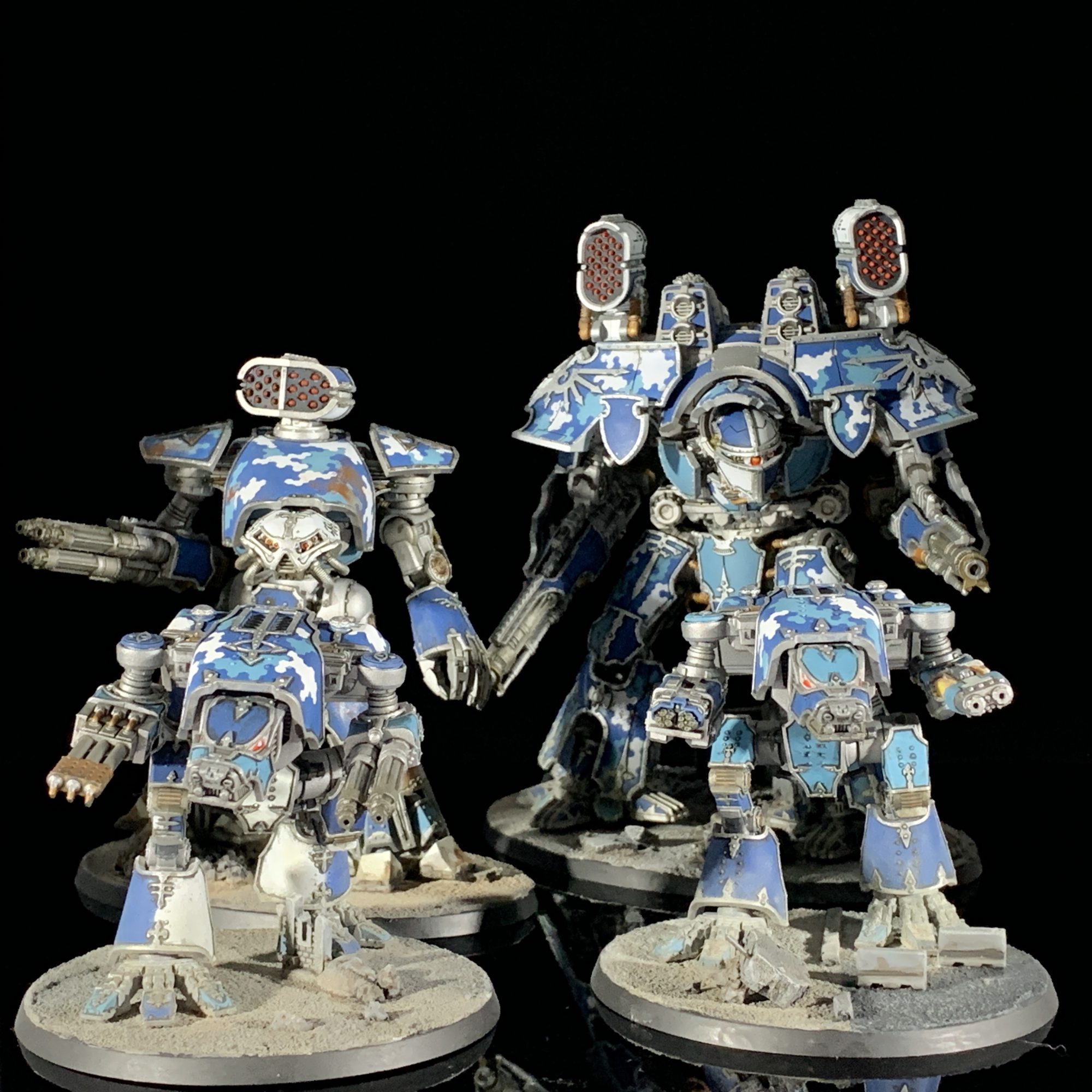
This book is invaluable for Traitor players. Not only does it give you all of the new toys we’ve been expecting, it also pulls together all of the rules you’ll need to play a game of Titanicus with a Traitor battlegroup. Between this, the core rules, and Loyalist Legios, you’ll have everything you need to play nearly any game of Titanicus. At the very least, never having to shuffle 3 or 4 books just to play a single game again is well worth buying this book.
Soggy: If anything this book solidifies that Traitors get the cool toys and I can’t wait to give them a go.

